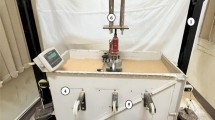Abstract
The design of embankments on soft foundations with the application of geosynthetics is a subject frequently studied. In addition, the disposal of mine waste material is a needed challenge, due to area availability. In this context, this work presents a study case of application of geosynthetics for soft foundations treatment, to make feasible the construction of a mine waste pile embankment. The study also presents a stress–strain analysis via finite-element modeling considering a critical state soil mechanics approach. Then, a geosynthetic liner and internal drainage system design is presented based on the results of this analysis. Hence, this liner and internal drainage are required due to the environmental concerns of the waste material. Thus, a discussion on the use of critical state soil mechanics and the stress–strain finite-element method to assess the need for treatment on foundation for embankments construction in soft material is presented. The deformations assessed at the stress–strain study showed that the waste material would absorb the foundation strains with only controlling the rising ratio. Thus, the solution proposed with the numerical analysis reduces the reinforcement that would be proposed usually. Furthermore, the ease installation process and the large strains capabilities made possible an embankment construction on soft soil near to a mine industrial plant.




















Similar content being viewed by others
Data availability
The participants of this study did not give written consent for their data to be shared publicly, so due to the sensitive nature of the research supporting data is not available.
References
Rowe RK, Li AL (2005) Geosynthetic-reinforced embankments over soft foundations. Geosynth Int 12:50–85. https://doi.org/10.1680/gein.12.1.50.59424
Li AL, Rowe RK (2001) Combined effects of reinforcement and prefabricated vertical drains on embankment performance. Can Geotech J 38:1266–1282. https://doi.org/10.1139/cgj-38-6-1266
Shuttle DA, Cunning J (2007) Liquefaction potential of silts from CPTu. Can Geotech J 44:1–19. https://doi.org/10.1139/T06-086
Jefferies MG, Been K (2016) Soil Liquefaction: critical state approach, 2nd edn. Taylor & Francis Group, Boca Raton
Lambe TW, Whitman RV (1969) Soil mechanics. John Wiley & Sons, New York
Jefferies MG, Shuttle DA (2011) Understanding liquefaction through applied mechanics. In: 5th international conference on earthquake geotechnical engineering. Santiago p 33
Rocscience (2018) RS2-2D geotechnical finite element analysis
Castro P, Martins P, Castro M, Amaral L, Carvalho B (2022) Geosynthetics design for a waste pile on soft soil foundations: analytical and numerical predictions for dewatering application under high load. In: 20th Global Joint Seminar on Geoenvironmental Engineering
Müller WW, Jakob I, Tatzky-Gerth R (2008) Long-term water flow capacity of geosynthetic drains and structural stability of their drain cores. Geosynth Int 15:437–451. https://doi.org/10.1680/gein.2008.15.6.437
Koerner RM (1933) Design with Geosynthetics, 5th edition. Pearson Education Inc, New Jersey
Lopes RF, Smolkin PA, Lefebvre PJ Geosynthetics interface friction: a challenge for generic design and specification, Ottawa-Carleton, Canada
U.S. Department of the interior Bureau of reclamation (2018) Design standards No. 13 embankment dams chapter 20: Geomembranes
Kumar Shukla S, Yin J-H (2006) Fundamentals of Geosynthetic Engineering, 1st edn. Taylor & Francis/Balkema, London
Vertematti, JC (2001) Curso básico de geotêxteis, 1st edition. Comitê técnico geotêxtil-Cbg, ABINT
Author information
Authors and Affiliations
Contributions
The authors confirm contribution to the paper as follows: formal analysis and modeling: PC, MC, LA, and BU; writing—original draft preparation: PC; supervision and writing—review and editing: PM.
Corresponding author
Ethics declarations
Conflict of Interest
The authors have no relevant financial or non-financial interests to disclose.
Additional information
Publisher's Note
Springer Nature remains neutral with regard to jurisdictional claims in published maps and institutional affiliations.
Rights and permissions
Springer Nature or its licensor (e.g. a society or other partner) holds exclusive rights to this article under a publishing agreement with the author(s) or other rightsholder(s); author self-archiving of the accepted manuscript version of this article is solely governed by the terms of such publishing agreement and applicable law.
About this article
Cite this article
Castro, P., Martins, P., Castro, M. et al. Use of Geosynthetic in Soft Soil Foundation in Mining Area: A Case Study with Analytical and Numerical Studies. Int. J. of Geosynth. and Ground Eng. 9, 12 (2023). https://doi.org/10.1007/s40891-023-00429-y
Received:
Accepted:
Published:
DOI: https://doi.org/10.1007/s40891-023-00429-y




